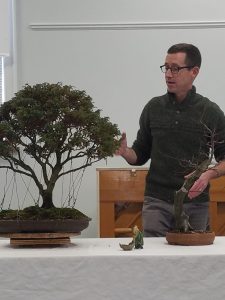Meg Hibbert
Contributing writer
 Ben Kirkland seldom passes by a small woodland tree or garden center specimen without thinking what he could do to make it into a work of art.
Ben Kirkland seldom passes by a small woodland tree or garden center specimen without thinking what he could do to make it into a work of art.
Kirkland’s specialty is bonsai or tiny trees trained to look like windblown forest dwellers. He showed how he does that at the Feb. 19 meeting of the Salem Garden Club.
The president of the Hinoki Bonsai Club in the Roanoke Valley admitted he has between 40 and 50 of the tiny, small and medium-size trees in a protected outside area at his Christiansburg home that he is training to be even more spectacular.
Kirkland first fell in love with bonsai as a 5-year-old child when his father was a Marine deployed to Japan and South Korea and sent back pictures of the countryside.
“Images of bonsai and oriental landscapes were always in my mind,” he said.
The word “bonsai” means “tree in a pot,” Kirkland explained. The art form started as a way to bring down from the mountains the five elements, he added.
About 12 years ago he started seeing if he could do bonsai in his back yard from Virginia native trees. His favorite is the American Hornbean, a hardwood like the one he dug up near Roanoke and has trimmed and trained to be a little over 1 foot tall – so far. Kirkland estimates it is about 15 years old.
For his talk he also brought a Pfitzer Juniper, a Shimpaku Juniper, a Sawara Cypress and a Chinese Privet he dug from a farm in Rocky Mount.
Other good trees to train into bonsai are Red Maple and even Eastern Red Cedar. “You work with the plants’ natural growth,” he added.
“I love my local flora,” said Kirkland, who is an instructor at Virginia Tech in Human Factors Engineering and Ergonomics.
He and other bonsai enthusiasts use soft aluminum wire to gently pull and turn trunks and branches, and prune branches to make them into shapes they want.
In the case of the 2-1/2 foot Sawara Cypress, Kirkland removed three of the tree’s four trunks and shaped it for a looser, more natural form. “They shouldn’t look like topiary,” he said. “Make sure it’s not a pom pom.”
A bonsai master he particularly likes, John Naka, described the look as “leaving space for birds to fly through, Kirkland said. “Think about leaving negative space as much as positive space,” he added.
Kirkland prunes his trees in early spring. For those who are considering trying their own bonsai, he cautioned them to notice if the tree they are starting with has good root structure, and the trunk tapers as it grows upward.
He showed Salem Garden Club members meeting at Salem Presbyterian Church different types of scissors to cut back small branches and leaves, clippers, shallow pots – both American-made and from Asia – and other tools of his trade. The “soil” he uses is not organic soil per se, but includes ground pine bark and fired clay.
He encouraged gardeners to learn more about bonsai at meetings of the Hinoki Bonsai Club at 7:30 p.m. the third Wednesday evening at the Roanoke Council of Garden Clubs building on Colonial Avenue. The club is also sponsoring classes on March 21.
The Hinoki Bonsai Club is a member of the Roanoke Council of Garden Clubs. For more information, see the club’s Facebook page, https://www.facebook.com/hinokibosaiclub or contact Kirkland at 540-250-8009.



